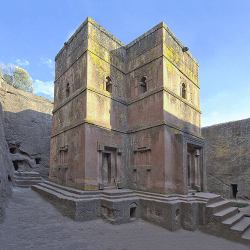UNESCO World Heritage Sites in Spain are:
- Alhambra, Generalife and Albayzín, Granada
- Burgos Cathedral
- Historic Centre of Cordoba
- Monastery and Site of the Escurial, Madrid
- Works of Antoni Gaudí
- Cave of Altamira and Paleolithic Cave Art of Northern Spain
- Monuments of Oviedo and the Kingdom of the Asturias
- Old Town of Ávila with its Extra-Muros Churches
- Old Town of Segovia and its Aqueduct
- Santiago de Compostela (Old Town)
- Garajonay National Park
- Historic City of Toledo
- Mudejar Architecture of Aragon
- Old Town of Cáceres
- Cathedral, Alcázar and Archivo de Indias in Seville
- Old City of Salamanca
- Poblet Monastery
- Archaeological Ensemble of Mérida
- Routes of Santiago de Compostela: Camino Francés and Routes of Northern Spain
- Royal Monastery of Santa María de Guadalupe
- Doñana National Park
- Historic Walled Town of Cuenca
- La Lonja de la Seda de Valencia
- Las Médulas
- Palau de la Música Catalana and Hospital de Sant Pau, Barcelona
- Pyrénées – Mont Perdu
- San Millán Yuso and Suso Monasteries
- Prehistoric Rock Art Sites in the Côa Valley and Siega Verde 28
- Rock Art of the Mediterranean Basin on the Iberian Peninsula
- University and Historic Precinct of Alcalá de Henares
- Ibiza, Biodiversity and Culture
- San Cristóbal de La Laguna
- Archaeological Ensemble of Tarraco
- Archaeological Site of Atapuerca
- Catalan Romanesque Churches of the Vall de Boí
- Palmeral of Elche
- Roman Walls of Lugo
- Aranjuez Cultural Landscape
- Renaissance Monumental Ensembles of Úbeda and Baeza
- Vizcaya Bridge
- Ancient and Primeval Beech Forests of the Carpathians and Other Regions of Europe
- Teide National Park
- Tower of Hercules
- Cultural Landscape of the Serra de Tramuntana
- Heritage of Mercury. Almadén and Idrija
- Antequera Dolmens Site
- Caliphate City of Medina Azahara
- Risco Caido and the Sacred Mountains of Gran Canaria Cultural Landscape
- Paseo del Prado and Buen Retiro, a landscape of Arts and Sciences
- Prehistoric Sites of Talayotic Menorca
> View other UNESCO World Heritage Sites
More on World Heritage Sites
UNESCO (United Nations Educational, Scientific and Cultural Organization) World Heritage Sites comprise 1,199 properties.

World heritage property is a legacy from the past, that people live with today, and pass on to future generations.

The cultural and natural heritage are both irreplaceable sources of knowledge and inspiration.





UNESCO seeks to encourage the identification, protection and preservation of cultural and natural heritage around the world that are considered to be of outstanding value to humanity. This is embodied in an international treaty known as the Convention concerning the Protection of the World Cultural and Natural Heritage, adopted by UNESCO in 1972.
A World Heritage Site is an area or landmark designated by UNESCO for having cultural, historical, scientific or other forms of significance. The sites have legal protection by an international convention.
A World Heritage Site is nominated by their host country and determined by the international committee to be a unique landmark which is geographically and historically identifiable and having a special cultural or physical significance. World Heritage Sites are usually ones with ancient features, historical structures, buildings, cities, deserts, forests, islands, lakes, monuments or mountains.
The site may signify a remarkable accomplishment of people and serve as evidence of intellectual history or a place of unparralled natural beauty.
The sites are intended for practical conservation for posterity, which otherwise would be subject to risk from human or animal trespassing, unmonitored, uncontrolled or unrestricted access, or threat from local administrative negligence. Sites are demarcated by UNESCO as protected zones.
The programme catalogues, names, and conserves sites of outstanding cultural or natural importance.
The work began with the Convention Concerning the Protection of the World’s Cultural and Natural Heritage. The convention was adopted by the General Conference of UNESCO on 16 November 1972. Since then, 195 states have ratified the convention, making it one of the most widely recognised international agreements and a popular cultural programme.








